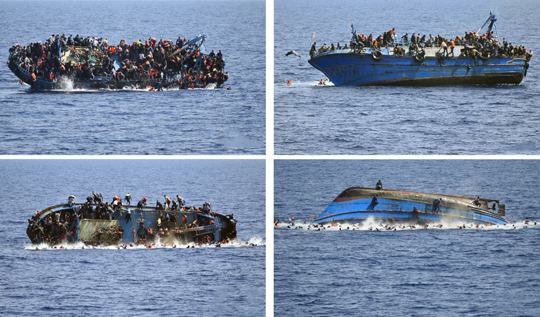Rome, Nov 16: Around 100 people were missing, feared drowned, in the Mediterranean today after a migrant dinghy capsized off Libya, according to rescue teams frantically searching for survivors in darkness and rough seas.

German NGO Jugend Rettet, whose boat was at the scene, said 23 survivors had been rescued by an oil tanker which was first to reach the stricken boat. "The crews are searching for survivors in the water and recovering dead bodies," it added in a tweet.
The survivors and four recovered corpses were transferred from the tanker to the Acquarius, a boat operated by another charity group, SOS Mediterranee. A survivor told one of that organisation's staff that the dinghy had begun to sink at 6.00 AM (local time), four hours before the tanker arrived.
"We were 122 on the boat, no children under 15, but there were 10 women travelling with us and only one survived," the survivor was quoted as saying.
"We waited in the water, taking any floating thing to remain afloat, but most of the people drowned, including my little brother. He was 15. "At 10 the tanker came and rescued us. I want to call home to tell them that my brother died."
Attempts to find any survivors were continuing but were being hampered by very rough conditions and the chances of finding anyone alive appeared slim.
The latest tragedy in the Mediterranean came the day after another incident in which it is feared dozens may have drowned after the sinking of another dinghy, from which there were only 15 survivors.
UN refugee agency (UNHCR) officials said today that dozens of people likely perished before a merchant ship reached that dinghy, which was of a type that normally have had 100-150 passengers packed on board.
The survivors were today onboard Italilan coastguard ship the Diciotti en route for the Sicilian port of Catania.
Exactly how many people died will not be known until it arrives but it would be unusual for traffickers to set sail from Libya with as few as 15 people onboard.
The coastguard said a total of 298 people were rescued in three operations today, taking the total rescued since Saturday to 2,600.
The coastguard confirmed the recovery of five corpses yesterday and SOS Mediterranee staff said they had seen another one floating in the water but had been unable to recover it.
The migrants rescued by the Aquarius included a large number of minors -- 24 yesterday, including three under five, and 47 today.
One young boy who was plucked unconscious from the water yesterday was said to be in a stable condition on the Italian island of Lampedusa after being helicoptered off the rescue boat.
The latest deaths add to a tally of 4,271 mostly African people who have died trying to cross the Mediterranean this year, according to the UN refugee agency.






Comments
At least 100 less cockroaches in the civilised world
Add new comment